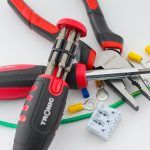Feeling overwhelmed by the jumble of cords and wires under your standing desk?
Wrangling those cables into a neat and organized system may seem daunting, but fear not! With the right strategies, you can conquer the cable chaos and achieve a sleek and professional-looking workspace.
In this guide, you'll discover practical tips and techniques for mastering cable management for your standing desk.
From assessing your cable needs to choosing the right tools and organizing cables for a tidy appearance, you'll learn the essential steps to keep your workspace free from tangled messes.
So, let's dive in and transform that cable jungle into a streamlined and efficient setup!
Key Takeaways
- Determine the number and types of cables used regularly at your standing desk.
- Plan the optimal cable routing techniques to declutter the workspace and minimize tripping hazards.
- Utilize cable management tools such as trays, clips, and ties to keep cables organized and prevent tangling.
- Regularly inspect and adjust cable placements to maintain a tidy and efficient work environment.
Assessing Your Cable Needs
Assess the number and types of cables you use regularly at your standing desk to determine your cable management needs.
To achieve an ergonomic setup, it's crucial to have a clear understanding of the cables you rely on. Start by identifying the various cables and their functions. Common cables include power cords, monitor cables, USB cords, and Ethernet cables.
Once you've determined the types and quantities of cables, consider the optimal cable routing techniques. This involves planning the paths the cables will take from the power source to your devices. Cable routing techniques not only declutter your workspace but also minimize tripping hazards and potential damage to the cables.
It's important to secure cables along the desk edges or use cable trays to keep them organized and out of the way. Additionally, investing in cable clips or ties can help keep individual cords neat and prevent tangling.
Choosing the Right Cable Management Tools
Consider using cable trays, clips, and ties to effectively manage and organize your cables, minimizing clutter and preventing tangling. When it comes to cable organization and wire storage, having the right tools can make a significant difference in maintaining a tidy and efficient workspace.
Here are some essential cable management tools to consider:
- Cable Trays: These are ideal for keeping multiple cables neatly organized and out of the way. You can easily mount them under your desk to route and conceal cables, ensuring a clean and professional look.
- Cable Clips: These versatile clips come in various sizes and are perfect for securing cables to the underside of your desk or along the edges, keeping them from tangling and making it easier to identify specific wires when needed.
- Cable Ties: Invest in reusable cable ties to bundle and secure groups of cables together. They're adjustable and can be easily repositioned, making it convenient to add or remove cables as needed while maintaining a neat and organized workspace.
Organizing Cables for a Clean Look
Once you have selected the appropriate cable management tools, you can begin organizing your cables for a clean and professional look by implementing a few simple strategies. Cable organization is crucial for achieving clean aesthetics in your workspace.
Start by grouping similar cables together using zip ties or cable clips. This will prevent them from tangling and create a neater appearance. Additionally, consider using cable sleeves or wraps to bundle multiple cables into one neat and uniform unit. These tools not only keep cables organized but also contribute to a streamlined and tidy look.
For a more advanced approach to cable organization, consider using cable management trays or under-desk cable racks to keep cables off the floor and out of sight. These solutions not only enhance the cleanliness of your workspace but also contribute to a safer and more organized environment.
Furthermore, utilizing cable raceways or conduit systems can help conceal cables along walls or under desks, further contributing to the aesthetics of your workspace.
Securing Cables to Prevent Tangles
Securing your cables with cable ties or clips is essential for preventing tangles and maintaining a tidy workspace. By properly securing your cables, you can prevent clutter and save time untangling wires, allowing for a more efficient and organized work environment.
Here are some tips for securing your cables effectively:
- Use Cable Ties: Invest in reusable cable ties to bundle together multiple cables. This will prevent them from tangling with each other and keep them neatly organized.
- *Pro Tip*: When using cable ties, leave a little slack in the cables to allow for movement without putting stress on the connectors.
- Cable Clips: Utilize adhesive cable clips to secure cables along the edge of your desk or the legs of your standing desk. This will keep them in place and prevent them from drooping or tangling.
- Labeling: Consider using cable labels or tape to identify each cable. This not only helps you keep track of which cable goes where but also prevents confusion and accidental tangles in the future.
Maintaining and Adjusting Cable Management Systems
To maintain an efficient cable management system for your standing desk, regularly inspect and adjust cable placements to prevent tangling and ensure optimal organization. Cable maintenance is crucial for preventing potential hazards and maintaining a neat workspace.
Start by checking for any loose cables or tangled wires. Untangle and neatly arrange them, using cable clips or zip ties to secure them along the desk frame or legs.
Regularly inspect the cables for wear and tear, replacing any damaged ones promptly. Additionally, reevaluate the placement of cables whenever you make adjustments to your desk height or configuration. This will help ensure that cables aren't stretched or strained, which can lead to damage over time.
Furthermore, consider using cable sleeves or raceways to further streamline cable organization and prevent tangling. By staying proactive with cable maintenance and organization, you can maintain a tidy and safe workspace, free from the hazards and frustrations of tangled cables.
Frequently Asked Questions
How Can I Prevent My Cables From Getting Damaged by My Standing Desk's Moving Parts?
To protect your cables from desk movement, secure them with cable sleeves or clips. Keep them organized and hidden with cable trays or adhesive clips for desk aesthetics. This prevents damage and maintains a tidy workspace.
Are There Any Specific Materials or Tools I Should Avoid Using for Cable Management With a Standing Desk?
Avoid using glue, tape, metal clips, and plastic ties for cable management with a standing desk. Opt for Velcro straps, cable sleeves, wraps, snakes, trays, raceways, clips, spines, boxes, tunnels, channels, hooks, hiders, organizers, labels, ties, and wraps for effective cable protection and routing.
What Are Some Common Mistakes People Make When Organizing Cables for a Clean Look on a Standing Desk?
When organizing cables on a standing desk, common mistakes include ignoring proper techniques. Avoid overcrowding power outlets, using cheap cable ties, and neglecting to label cables. Instead, opt for cable management solutions and take the time to organize and label your cables.
Can I Use the Same Cable Management Techniques for a Standing Desk as I Would for a Traditional Sitting Desk?
Yes, you can use similar cable management techniques for a standing desk as for a sitting desk. Ensure an ergonomic setup and tidy cable organization. Use cable management techniques to keep your workspace clean and organized.
Are There Any Ongoing Maintenance Tasks I Should Be Aware of for My Standing Desk's Cable Management System?
To maintain your standing desk's cable organization, regularly check for wear and tear, secure loose cables, and use cable management accessories. Long term effects of neglecting cable maintenance can lead to safety hazards and reduced efficiency.





